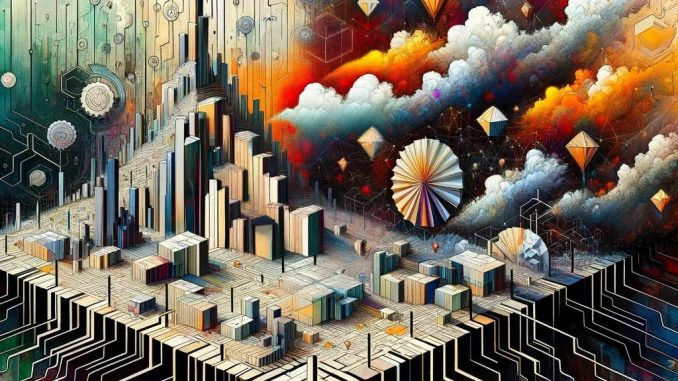
How “In There” Differs From “Out Here”
So Hiro’s not actually here at all. He’s in a computer-generated universe that his computer is drawing onto his goggles and pumping into his earphones. In the lingo, this imaginary place is known as the Metaverse. Hiro spends a lot of time in the Metaverse. It beats the shit out of the U-Stor-It.
— Neal Stephenson, Snow Crash (1992)
Consider that Bitmap is not really about building a Metaverse.
Consider that Bitmap is about building a better world.
As long as the concept of virtual spaces has existed, science fiction has portrayed these spaces, not as utopias, but as a necessary escape from dystopias.
Consider that we’re living in one of those dystopias right now.
Consider that the reason why we so strongly desire to build a better world in there is because we all intuitively know there is something wrong with the world out here.
But why? What’s the difference between out here and in there?
As discussed in the first article of this series, “You Live In A Bitmap”, the only valuable metaverse is one built upon a decentralized, immutable substrate, like Bitcoin provides. Anything else may be a metaverse, but will not be The Metaverse.
Put simply, centralized institutions empower certain humans to rule over other humans, the worst people always wind up on top. The strong use institutions to exploit the weak.
Centralization is predicated on the arbitrary. Fiat currency is printed and devalued at the whim of the central government. Wars are initiated at the whim of the central government. Justice is proclaimed at the whim of the central government.
Every problem we experience as a society stems from this faulty foundation.
This is why we’re stuck in a social Groundhog Day. No matter how much technology advances, the problems keep repeating. The strong still exploit the weak. Homelessness, poverty, war, hatred — these ills seem only to be increasing, despite (or perhaps because of) our advancements.
How do we break the cycle?
We need to build things in there differently than we built them out here.
The good news is that we have a powerful tool, one that never existed through human history until very recently.
Bitcoin offers us a decentralized, immutable substrate to build upon. What can we build on top of Bitcoin? Anything we want, right?
No. Because if we could build anything we wanted, this wouldn’t be any sort of immutable, persistent reality. It would be an arbitrary sandbox, one in which all of the points are made up and don’t matter.
A persistent reality is defined, not by creative freedom, but by creative constraint.
Creative constraint is another way of saying that everything we do must be anchored to “reality” — which in the context of a Metaverse rooted in Bitcoin means block data.
A more practical way to understand the concept is to say that a truly decentralized, persistent Metaverse is simply true, as opposed to contingent on human decision making. Only such a Metaverse is worth building at all.
But how can we each build the worlds we personally wish to live in, within the construct of a single unified truth?
Consider these as foundational concepts for answering that question:
Decentralized, Protocol-Driven Governance
The government was set to protect man from criminals, and the Constitution was written to protect man from the government.
— Ayn Rand, The Virtue Of Selfishness, 1964
Everything that defines the Metaverse — not each individual’s personal metaverse, but The Metaverse — must be on-chain, protocol-driven, and independent of human action. Otherwise, it is destined to fail.
For the same reasons things fail out here — anything that relies on trusting humans creates incentives for corruption and abuse, which always inevitably materialize.
This means that the definition of what is or is not part of “The Metaverse” must be protocol driven, defined by adherence to a set of agreements.
Far from a government, think of this as an anti-government. A protocol of protocols: a metaprotocol. Designed to empower freedom with minimal constraints, besides the necessary constraints of non-arbitrariness, persistence, and objective truth.
A practical example of this metaprotocol would be answering the question: “If I create a portal from my Bitmap to someone else’s Bitmap, what rules govern the relationship between the two? Which elements are in common, and which are not?”
Given that context, what degrees of freedom do I have to make arbitrary choices about MY metaverse, within the shared context of The Metaverse?
Autonomy Within Shared Protocols
I like mine with lettuce and tomato
Heinz 57 and french-fried potatoes
Big kosher pickle and a cold draft beer
Well, good god Almighty, which way do I steer?— Jimmy Buffett, Cheeseburger In Paradise
Anything not covered by the metaprotocol is, by definition, at the whim of individual creators.
This autonomy is critical to metaverse development, because everyone has their own idea of paradise.
As such, we must design the metaprotocol to be minimalist and principle-driven, to allow as much freedom as possible for individual builders to realize their vision within the greater Metaverse.
Let 1,000 flowers bloom. Users will decide which ideas are the best, and those ideas will thrive.
Flexibility & Neutrality
We must not become married to any set-in-stone principles beyond those which are fundamentally necessary to the metaprotocol. Put more simply, we must not dictate what The Metaverse can be or should be. Instead, we must remain flexible and neutral.
Flexibility means that we create protocols with the intention of interoperability. We consider the full degrees of freedom within which creativity can flow.
Neutrality means that we don’t take dogmatic positions about what is right or wrong within the context of those freedoms. It means we build tools that can be used as easily for evil as good. Without that neutrality, that agnosticism of purpose, we are destined to build another centrally controlled dystopia.
Let’s suppose for a moment that we’re on the same page about those principles. Building this will be easy right? We need only set up the tech in such a way, and voila.
But there’s something we haven’t talked about. The “what” is not as hard to solve for as the “how”.
Building a decentralized, open-source project is vastly different from building in a top-down, centralized manner. Rather than a single leader, or a leadership caste, dictating what should be done, in what order, for what purpose, a decentralized project doesn’t belong to any one individual or group — there is no leader.
This creates an inherent coordination problem; one which can be looked at as an obstacle, but which I encourage you to instead think of as an extraordinary strength.
In my view, we must adapt our thinking now to meet this challenge, by implementing a decentralized perspective on project management. These are the “Ten Tenets” I believe we can use to arrive at better outcomes more quickly:
- Consensus Over Hierarchy: Decentralized projects require overcoming barriers and doing the hard work of creating consensus, which involves persuading people and allowing the best ideas to prevail.
- Incentive Structures: Incentives in open-source projects need to make sense to the community, driving participation through intrinsic motivation like reputation and recognition.
- Transparent Processes: Transparency is crucial as it allows for open discussions and visibility into all aspects of the project, fostering trust and collaboration.
- Distributed Leadership: Leadership roles are fluid and merit-based, requiring individuals to persuade others and prove their ideas through merit.
- Let 1,000 Flowers Bloom: Avoid roadmaps. Instead, create degrees of freedom within which creators can experiment. Encourage creative freedom, and select the best ideas for further development.
- Voluntary Participation: Contributors participate voluntarily, driven by passion for the project and belief in its vision.
- Adaptability and Evolution: The ability to adapt rapidly based on community feedback ensures that the project evolves continuously, overcoming difficulties and barriers.
- Diversity of Perspective: Contributions come from a diverse pool of perspectives, enhancing innovation and ensuring the best ideas win out.
- Decentralized Funding: Funding is driven by the community, ensuring that financial support aligns with the project’s goals and the community’s values.
- Focus on Long-Term Value: The focus is on building something strong, anti-fragile, and permanent, ensuring long-term sustainability and community benefit.
Building a persistent immutable reality in there is our best chance to create the world we wish to live in.
Maybe one day we’ll learn those lessons out here too.
Thank you for reading. All artistic images created by Elevated Dabber with the assistance of GPT 4 / DALL-E 3.
If you enjoyed, please follow here as well as repost on X!


